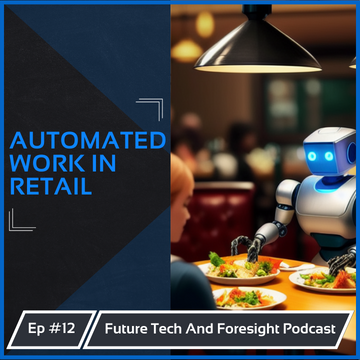About The Episode
How will automated kiosks impact both the retail and fast food industry? Also will these automation technologies act as a job creator or job destroyer?
Additional Notes:
Documentary: https://www.pbs.org/video/in-the-age-of-ai-zwfwzb/
Transcript
Almost as soon as I published last week’s episode on 3D printing I came across an article that described some 3D printed organs, which as I had mentioned, was one of the main challenges of ending the black market organ trade. In April of this year, researchers in Tel Aviv Israel were able to print a full vascularised heart that has combined human DNA into it. It apparently completely matches all anatomical properties of a human heart, with one catch…it’s really really small. Equivalent to the size of a rabbit heart. Though the small heart would need to be developed further and trained to pump properly, 3D printing technology is not far off from printing a full sized heart. Thus the illegal organ market might be ending sooner than expected, hopefully.
But moving onto today’s podcast, we are going to look at the automated kiosks, most of us have come into contact with by now. But the touch screen technology that we are seeing more and more in grocery stores, restaurants, airports, etc is not a new idea. The first coin operated vending machine were actually introduced in London as far back as 1883 where it dispensed postcards, but quickly grew to giving out things like envelopes and newspapers. Today it’s unlikely that you will go to any transportation station, without seeing modern vending machines of some kind rather than people selling snacks or newspapers. One of the points of culture shock for me about 10 years ago when I backpacked across Latin America was that at every bus stop, vendors would hop onto the bus and sell their goods to passengers all the time. After a few months of travelling I lost count of the number of times I had bought some plantain chips, or fresh fruit from these hard working people. Though this isn’t the case in most parts of the West many people around the world still make their living this way. Famously in 2010 in Beijing China, there was a 12 day 100km long traffic jam where a small ecosystem of trade even sprung up.
The ATM is another predecessor of the modern automated kiosk which had some 3.5 million installed worldwide before starting to drop in use due to cashless payment systems. Of course, the vending machine, ATM, and modern automated kiosk enable access to a good with no human interaction, in a fast and efficient way. Additionally, these Kiosks also give employees fewer opportunities to steal money, which is a big problem in retail. For these reasons it is estimated that the automated kiosk market will grow to $34 billion by 2023.
Examples of Automated Kiosks
McDonalds started rolling out kiosks in 2015, and plans to open 1,000 kiosks per quarter through 2020. And it was only in September that Mcdonalds acquired a business in order to implement AI into it’s kiosks to improve the recommendations of other products for orders. The expectation is that with the recommendations that are more personalised based on your previous purchasing habits, time of day, weather, etc it will be easier to coax you to order more with every visit. Though initially it will be just implemented in all US and Australian drive-throughs by the end of 2019, the goal is to have this in all store kiosks as well.
However, if you’ve ever used one of these, you still are required to complete your purchase using your card for the most part. In China, perhaps you’ve heard that this is done a little differently. Alipay first rolled out its Dragonfly facial recognition system at the end of 2018 and has expanded it to over 300 cities in China. This enables a customer to simply look at a screen, input a single account number, and walk out of the store after the attendant has scanned their purchase, with the system linking their face and purchase to their account. However, this has already been taken a step forward. Amazon launched their cashier-less convenience store in 2018, the Amazon Go. Today, 18 of these stores are found across a few US states and enable people to walk into their store, and through the use of sensors, computer vision and a simple pre-installed app, the store will track you, the goods selected and charge your account without you having to scan each item individually as you have to do in the automated check out counters today. Also, there is no standing in the checkout line waiting for the person in front of you to pay anymore. Though this is fully functional in only a few stores right now, China already has hundreds of these stores using slightly less advanced technology, like the RFID tag in each of Bingo Box’s products. However this essentially enables the same thing.
This trend we are moving towards doesn’t come without its concerns. Though the convenience of simply walking into a store, choosing what you want, and walking out without the time wasting hassle of waiting in line, does sound amazing, the additional data collected from our purchasing habits by these companies should be alarming for anyone listening to this. If you’re interested in this topic I’ll link in the shownotes a terrific documentary that I was recommended that goes into today’s data and privacy concerns, as well as the current technological competition between the US and China. It’s called ‘In the Age of AI” and can be found on pbs.org.
But apart from the data collection concerns, the more relevant impact for this podcast is that of jobs.
Impact on Jobs
One of the first examples I used in this podcast back in episode 2 was of the ATM and how it was seen as the technology that would eliminate all bank tellers. However, the opposite occurred as the savings enabled more bank branches to open requiring the need of more bank tellers to operate them. Now this might very well be the case for the examples of McDonalds and others that use the automated kiosks as a supplemental technology to the stores that are already there. With increased efficiency and lower wait times, revenues can increase and more stores can open up. However, with the Amazon Go type stores that require literally zero staff I cannot see this argument applying. Now this doesn’t mean that jobs won’t be created, it takes a tremendous amount of work and skills to be able to design and build stores like this so they function properly: reducing any possibility for theft, having people charged for exactly what they take, and properly attach the person to their purchase and not someone else. However, retail jobs such as cashiers have traditionally been entry level positions that enable many to have a first working opportunity. For example, my first job working at McDonalds. I was both a cashier and drive thru attendant and it enabled me to save up enough money to buy my first car and even helped contribute to my university admission. And during university I had friends and family working at university bookstores to help pay for their tuition, and of course get deals on the ridiculously expensive textbooks every student dreads buying. Even if these technologies aren’t implemented across all possible retail jobs, the reduced opportunity for early entrants to the job market, or students to pay for their studies is a real problem that we as a society will have to discuss.
Perhaps an even more present job for early entrants and students is that of waiting in restaurants that is also now starting to be threatened.
Automated Restaurants
I remember the first time I went to Amsterdam right before starting my Masters and when walking around I kept noticing these fast food shops that had entire storefronts with nothing but deep fried snacks vending machines where you could put in a few coins and the small door would open up, you’d get your snack, and the staff attendant would begin to fry up another one for the next person. But this still requires human staff to prepare the food. There are today more advanced examples.
Google recently invested in ‘Creator,’ a burger shop that has the preparation of the burger completely automated. There are still staff members but only to check on the machines, and take orders, which we know can be also be automated with the implementation of a McDonalds like kiosk. Another example is Cafe X. This utilises a modified industrial robot arm as well as an automated kiosk screen. The robot barista can make two drinks in under a minute and apparently gets your order right every single time. Though the entire setup is automated and doesn’t require any human interaction, Cafe X like many automated solution companies have received criticism for essentially stealing jobs that humans can do. However, Cafe X also has a coffee specialist on site at every location to both discuss the coffee options and aid customers with the process if they so need it. However, if you’re a bit more picky with your coffee and appreciate some latte art this option might not be for you as the robot isn’t there yet. An upgraded station is planned that will include a collaborative mode where a human staff worker can start an order and a robot can finish it, while also being able to make three coffee order in 40 seconds. Finally, I visited Silicon Valley last year to speak at a conference on robots in industry and during the weekend I visited San Francisco for the first time. One of the things I did was go to Eatsa, a small automated restaurant that has the same premise as Cafe X, though instead of coffee they have entire meals. No human interaction necessary, simply order and wait for your food to be digitally labeled on one of the many boxes on the store’s wall. The healthy quinoa based meal that the restaurant chain specialize in was actually quite decent for being prepared by robots. Though a number of the stores have closed in the past year due to hasty over-expanding, The company has now pivoted to supporting other restaurant companies incorporate its technology, so it’s fair to assume that we can see more of these fully automated restaurants coming out in the years to come.
But there is an interesting situation that comes up specifically related to the automation of restaurants. A few years ago I had a short debate with a friend who was against the idea entirely, namely on the grounds that he prefers to interact with the restaurant staff and have the human interaction as part of the eating out experience. Though I tend to agree with him and this could act as a limiting factor for the growth of automation in this sector, this is an argument that is presented against most new technologies in general, namely that the old way of doing things is comfortable to the generation that grew up with that way, and there is perceived loss in the modification of that activity. However, newer generations that are exposed to the new technology don’t have this same issue. Thus if automated restaurants, cafes, and burger bars are to become more common, the argument that human interaction between customer and staff is crucial to a dining experience might not even be considered in a few short years by younger people. But what about you? Would you be comfortable going to restaurants and simply ordering your food from a kiosk screen and having it delivered by a robot like in some sci-fi movies?
That’s it for this week, please be sure to review the podcast if you haven’t done so already as it does help others to find out about it. Next week we’ll look at automation within the military.
Thanks for listening.











